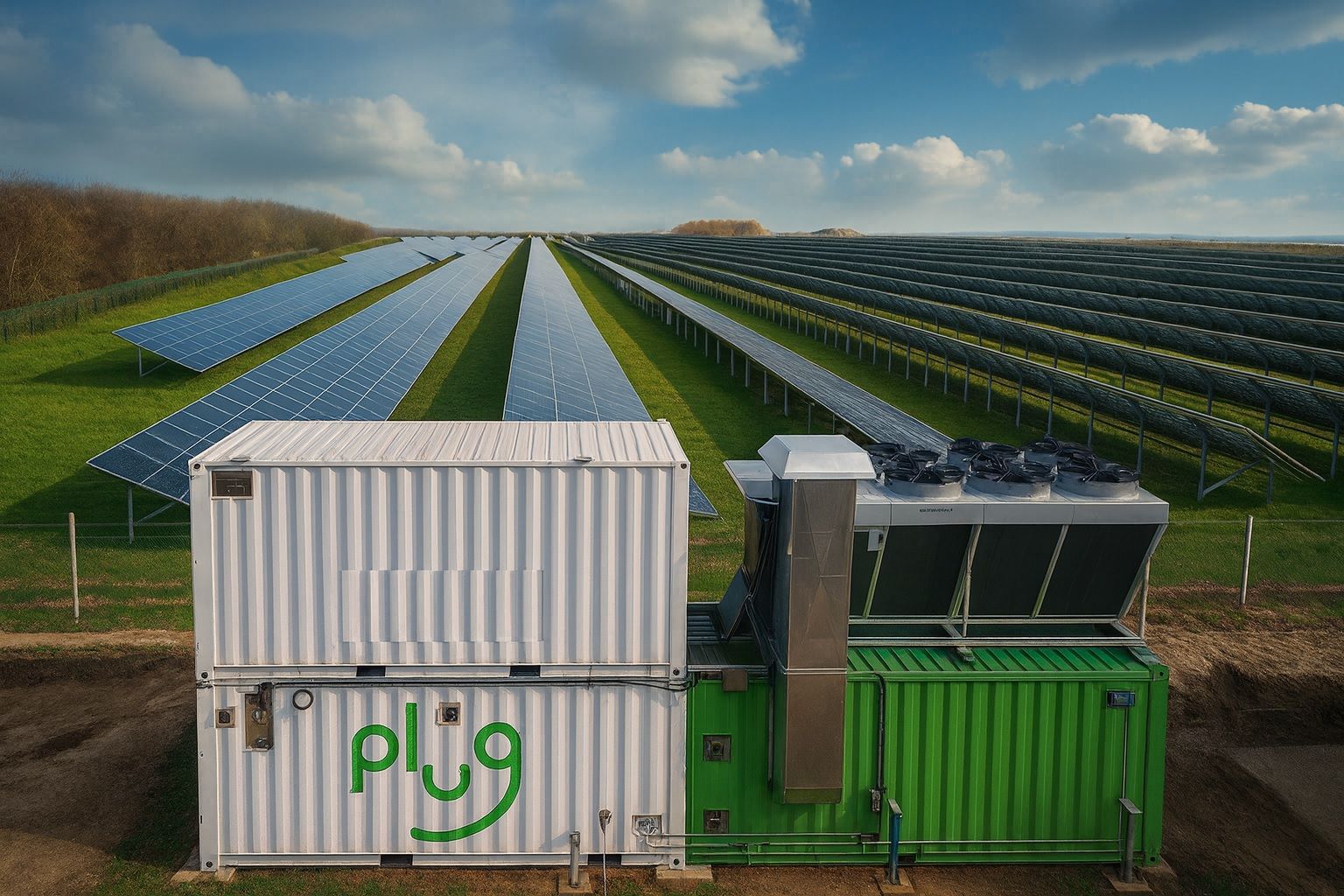- Stock surge: Plug Power (NASDAQ: PLUG) shares have more than doubled since early September, hitting a 52-week high above $4.50 in early October, before pulling back to the mid-$3s [1] [2]. The stock traded around $3.40 on Oct. 17 (down about 5% on Oct. 15) after a massive rally [3]. PLUG is up roughly 65% year-to-date, making it one of 2025’s top-performing clean-energy stocks [4].
- Catalysts: Analysts and investors point to hydrogen industry catalysts. On Oct. 3, H.C. Wainwright blasted PLUG’s 12-month price target to $7 (from $3), sending the stock up 34.6% that day [5]. Around the same time Susquehanna and others raised targets. Major project news – notably Plug’s first 10 MW electrolyzer delivery in Portugal – added fuel. A classic short squeeze drove shares higher, since roughly 30–40% of PLUG’s float was sold short [6] [7].
- Financial snapshot: In Q2 2025 (reported Aug. 11), Plug Power earned $173.97 million in revenue (up 21% year-on-year) [8] [9]. Costs are coming down: gross margin improved to –31% vs –92% a year earlier [10]. However, the company still lost $0.16 per share (vs. an expected –$0.15) [11], and remains unprofitable (net margin –293% in Q2 [12]). Plug ended Q2 with ~$140 million in cash and a $300M credit line [13]. In early October it raised $370M via a creative warrant exercise, potentially unlocking up to $1.4 billion more if new warrants are fully exercised [14].
- Leadership: On Oct. 7 Plug Power announced a management change [15]. Longtime CEO Andy Marsh will become Executive Chairman in 2026; current CRO José Luis Crespo (who helped build Plug’s ~$8B sales pipeline) takes over as president on Oct. 10 and CEO after the 2025 annual report [16]. Shares fell ~3% on the news [17] as investors digested the transition, but analysts view Crespo’s appointment as continuity in strategy.
- Analyst views: Experts are divided. One prominent analyst (HSBC) upgraded PLUG to “Strong Buy” on Oct. 9 [18], and H.C. Wainwright remains the most bullish with a $7 target [19]. The Motley Fool even predicted PLUG “could soar 50% by 2026” on current trends [20]. However, most Wall Street analysts remain cautious: consensus rating is roughly Hold [21] [22] and the average 12-month price target is only around $2.20–$2.50 [23] [24] – about 30% below recent trading levels. In other words, many see the recent runup as overheated. One commentator warned the Oct. 15 pullback followed “an unsustainable ~150% surge” and reflected “deeper concerns about the company’s financial health” [25].
A Plug Power facility marked “Green Hydrogen at Work.” The hydrogen fuel-cell maker’s stock has seen a “wild ride” in October as investors chase a hydrogen boom [26] [27].
Stock Rally and Volatility
Plug Power’s stock has exploded higher this fall. After spending much of the summer under $2 per share, PLUG jumped from the low-$2s in early September to over $4 by mid-October – roughly a 170% gain in six weeks [28] [29]. On Oct. 6 the stock briefly hit ~$4.50 intraday – a one-year high – on the back of bullish news and buying frenzy [30] [31]. Even after a late-week pullback (Oct. 15’s ~4.8% drop and Oct. 17 close around $3.40 [32]), PLUG is still far above its 52-week low of $0.69 [33].
This volatility is striking. PLUG’s 50-day moving average is only about $2.17, and its 200-day average about $1.52 [34], far below the current price – signals of an overbought condition. Trading volumes have spiked. In one session the stock fell nearly 10%, and call options volume jumped 66% above normal levels during the October run [35] [36]. With PLUG’s beta around 2.2 [37], it’s been swinging far more than the broader market. Remarkably, this red-hot performance lifted PLUG ~65% YTD [38], vastly outpacing the S&P 500’s flat-to-down performance. Bulls argue that the uptrend remains intact so long as PLUG holds above roughly $3; bears warn that the stock is ripe for consolidation.
Catalysts: Analyst Upgrades & Hydrogen Deals
Analysts’ bullish calls and real-world hydrogen news ignited the rally. On Oct. 3 H.C. Wainwright’s Amit Dayal issued an “ultra-bullish” note on PLUG [39]. Dayal reiterated a Buy rating and doubled his 12-month target from $3 to $7 [40], arguing that surging electricity prices and renewed nuclear energy policies are making green hydrogen more economically competitive [41] [42]. That single upgrade triggered a 34.6% one-day spike [43], the stock’s largest gain in years. Around the same time, Susquehanna’s analysts lifted their target to $3.50 [44] (from $1.80) and Craig-Hallum bumped its target to $4 (from $2), citing improving fundamentals. These calls helped flip market psychology from skepticism to fear of missing out.
Fundamentals backed the hype. Plug Power announced it had delivered the first 10 MW unit of a 100 MW green hydrogen electrolyzer project at Galp Energia’s Sines oil refinery in Portugal [45]. This is one of Europe’s largest PEM electrolyzer installations, expected to produce ~15,000 tons of renewable hydrogen annually and reduce over 100,000 tons of CO₂ per year [46]. CEO Andy Marsh touted the project as proof that “large-scale hydrogen is ready today” [47]. In July, Plug also extended a long-term hydrogen supply deal in the U.S. through 2030 [48], guaranteeing lower-cost hydrogen for its fuel-cell refueling network. These partnerships – along with reports of a 2 GW electrolyzer deal in Uzbekistan – show Plug locking in both demand (electrolyzer orders) and supply (fuel for its GenFuel business).
The result: bears were squeezed out. Going into October, over 30% of PLUG’s float was sold short [49]. As the stock rocketed up, many shorts rushed to cover, driving prices even higher in a self-reinforcing loop [50]. The effect spilled into other hydrogen names: Ballard Power (BLDP) jumped ~23% on Oct. 3 with no company-specific news [51]. In short, a one-two punch of analyst enthusiasm and high-profile projects created a perfect storm for Plug’s shares [52] [53].
Financials and Balance Sheet
While hype has dominated headlines, Plug Power’s recent results do show real progress – even if profitability remains elusive. In Q2 2025 (ended June 30), Plug reported $174.0 million revenue – a healthy 21% rise year-over-year [54] [55]. Growth was broad: forklift fuel cells (GenDrive), hydrogen fueling (GenFuel), and especially electrolyzers (GenEco) all contributed. Electrolyzer revenue jumped by about 3× to roughly $45M [56], reflecting the ramp-up of green-hydrogen projects.
Crucially, Plug’s costs are coming down. Aggressive cuts under its “Project Quantum Leap” initiative helped improve Q2 gross margin to –31%, versus –92% in Q2 2024 [57]. The company slashed overhead via layoffs, plant consolidations, and supply-chain efficiencies. As a result, cash burn is slowing: unrestricted cash was about $140M at June 30 (pre-raise) [58], and Plug also has a $300M undrawn credit line [59]. In October, management disclosed a clever financing: an investor agreed to early-exercise 185.4 million warrants at $2/share, instantly injecting $370M into Plug [60]. Plug issued new warrants at $7.75 strike in return, potentially raising up to $1.4B more if exercised [61]. While those warrants may never be worth exercising, the deal greatly strengthens the balance sheet and removes a looming funding overhang.
Despite the progress, losses remain sizable. Q2 net loss was about $228.7 million (–$0.16 per share), slightly worse than the –$0.15 analysts expected [62]. Wall Street noted Plug’s net profit margin was a grim –293% for Q2 [63]. The company still consumes hundreds of millions of cash annually. Plug has never reported an annual profit – it generated roughly $7 billion in accumulated losses through 2024 [64] – and 2025 will be another losing year. Analysts forecast continued red ink in 2025 and 2026, with breakeven not likely until 2027 or beyond. On Plug’s Q2 earnings call, Marsh emphasized that cost cuts are starting to bear fruit, and he expects hydrogen costs to fall in H2 2025 as Plug’s own production ramps up [65]. For now, the company’s strategy is clear: raise cash at these elevated prices and invest in growth (especially electrolyzers and green hydrogen plants), hoping to bridge the gap to profitability.
Leadership Transition
Amid the excitement, Plug Power announced a big management shift. Reuters reported that on Oct. 7 the board named José Luis Crespo – then Chief Revenue Officer – as the next CEO [66]. Crespo, a Plug veteran since 2014, will become President on Oct. 10 and formally assume CEO duties after the 2025 annual report (March 2026) [67]. Longtime CEO Andy Marsh (at the helm since 2008) will transition to Executive Chairman. The stock dipped about 3% on the news [68], as investors weighed the change. But analysts noted Crespo’s strong track record: he “has been credited with building Plug’s $8 billion sales pipeline” and solid ties with major customers like Amazon, Walmart and Home Depot [69]. In short, the handover seems orderly, signaling continuity. Crespo himself told CNBC that electrolyzer projects and fuel-cell systems (e.g. forklifts) will drive growth going forward [70]. Going ahead, Plug’s performance under Crespo’s leadership – especially meeting execution on big projects – will be closely watched by investors.
Analyst Sentiment and Forecasts
Wall Street’s view of PLUG is a mixed bag. The recent surge has drawn both cheerleaders and skeptics. On the bullish side, a number of analysts have upgraded their outlooks in October. HSBC raised its rating to Strong Buy on Oct. 9 [71]. H.C. Wainwright (the most optimistic) just maintains a Buy and $7 target. Even some broader tech bulls have taken notice: a Motley Fool analysis claimed Plug’s recent moves “could soar 50% by 2026 if [the] trend continues” [72]. InvestorsObserver quoted Oppenheimer’s Colin Rusch saying Plug is “executing well on critical initiatives” and that Q3 earnings could be “the first meaningful step in the platform’s recovery” [73]. In other words, some experts believe the stock is priced for delivery on its hydrogen projects.
On the cautious side, many analysts are unimpressed. Of major firms covering PLUG, roughly half still rate it Hold or Sell [74]. The consensus 12-month price target is only about $2.20–$2.50 [75] [76], significantly below today’s price. (By comparison, during early Oct, the consensus target was under $2 [77].) Equities desks worry Plug’s valuation reflects hype more than fundamentals. As one commentary bluntly noted, Plug “has never turned a profit” and the latest share-price surge came even as the company reported another quarterly loss [78]. In short, many experts see the risk of a pullback if the stock outpaces results. Still, some remain hopeful: analysts have wide-ranging forecasts ($1 to $7 targets) but several eye the next catalysts – namely project wins or surprisingly good earnings – to justify further gains [79] [80].
Hydrogen Policy and Market Trends
Plug Power’s fortunes are closely tied to the broader hydrogen economy, which is getting a big policy boost. In July 2025, the U.S. Congress passed the so-called “One Big Beautiful Bill” energy package (H.R.1) that extends key tax incentives for hydrogen and fuel cells [81] [82]. Among other things, the law reinstated a 30% Investment Tax Credit (ITC) for fuel cell systems through 2032 and kept the green-hydrogen Production Tax Credit (PTC) alive for projects started by 2028 [83] [84]. Plug’s CEO Andy Marsh hailed this as “one of the most meaningful policy wins” for the company and the whole hydrogen sector [85] [86]. Those subsidies have real effects: the fuel-cell ITC encourages companies to buy Plug’s GenDrive forklifts (used by Amazon, Walmart, etc.), and the H₂ credits make big electrolyzer projects more economical. Across the globe, governments are pushing hydrogen for decarbonization – from Europe to Asia and Australia – implying strong long-term demand. Industry analyses project very high growth rates in green hydrogen use over the next decade (30–40% per year or more) [87].
Investors are also watching related clean-energy trends. Rising natural gas prices and data-center power demand have made many look to alternative energy sources. H.C. Wainwright pointed out that “surging electricity costs” will make green hydrogen more attractive [88]. Meanwhile, peers in the hydrogen and fuel-cell space are moving – Ballard Power’s stock has jumped in sympathy with Plug [89] [90], while other clean-energy names (e.g. Bloom Energy, FuelCell Energy) have lagged or fallen on their own news [91]. In short, Plug Power is trading partly on sector momentum. The question for investors is whether global hydrogen demand truly takes off as planned, and whether Plug’s integrated model of fuel cells plus hydrogen production will capture enough of that market.
Technical Outlook and Risks
From a technical standpoint, Plug Power appears stretched. All the momentum indicators and moving averages are currently deep in overbought territory [92]. A sharp correction is always possible – and indeed, one came on Oct. 15 (the stock fell ~4.8% that day [93]) and again in a 9.6% slide during October’s frenzy [94]. Traders note that after parabolic runs, stocks often consolidate or oscillate. The “RSI and trading volume extremes” seen recently suggest bulls should be ready for chop [95]. In the very near term, technical analysts will watch whether PLUG can hold support around $3.00–$3.20; a break below that could signal deeper profit-taking. Conversely, a bounce above $4.00 on strong volume could resume the uptrend.
Plug’s volatility also translates into high risk: its stock has roughly 3× the volatility of the S&P 500 (beta ~2.2 [96]), meaning big moves in either direction. Margin pressure and cash burns mean any hiccup – say, weaker-than-expected Q3 guidance or further dilution from financing – could spook investors. As TechStock² analysts warned, PLUG’s “elevated level still hinges on future execution and hydrogen market growth” [97].
Bottom line: Plug Power is in the spotlight as hydrogen hype reaches fever pitch. Its stock surge reflects real wins (policy support, project deliveries, analyst optimism) but also a speculative frenzy. The days ahead hinge on whether Plug can continue executing – hitting milestones on its electrolyzer and fuel-cell rollouts – and on broader energy trends (power costs, government backing for green hydrogen). For now, experts say the rally has legs in the short run, but caution that PLUG remains a high-risk play with a “story” stock feel [98] [99].
Sources: Authoritative financial and news outlets (Reuters, MarketBeat, Yahoo Finance, etc.) and TechStock² (ts2.tech) analysis [100] [101] [102] [103]. Citations link to the original reporting.
References
1. ts2.tech, 2. ts2.tech, 3. ts2.tech, 4. ts2.tech, 5. ts2.tech, 6. ts2.tech, 7. ts2.tech, 8. ts2.tech, 9. ts2.tech, 10. ts2.tech, 11. ts2.tech, 12. ts2.tech, 13. ts2.tech, 14. ts2.tech, 15. www.reuters.com, 16. www.reuters.com, 17. www.reuters.com, 18. ts2.tech, 19. ts2.tech, 20. ts2.tech, 21. ts2.tech, 22. ts2.tech, 23. ts2.tech, 24. ts2.tech, 25. ts2.tech, 26. ts2.tech, 27. ts2.tech, 28. ts2.tech, 29. ts2.tech, 30. ts2.tech, 31. ts2.tech, 32. ts2.tech, 33. ts2.tech, 34. ts2.tech, 35. ts2.tech, 36. ts2.tech, 37. ts2.tech, 38. ts2.tech, 39. ts2.tech, 40. ts2.tech, 41. ts2.tech, 42. ts2.tech, 43. ts2.tech, 44. ts2.tech, 45. ts2.tech, 46. ts2.tech, 47. ts2.tech, 48. ts2.tech, 49. ts2.tech, 50. ts2.tech, 51. ts2.tech, 52. ts2.tech, 53. ts2.tech, 54. ts2.tech, 55. ts2.tech, 56. ts2.tech, 57. ts2.tech, 58. ts2.tech, 59. ts2.tech, 60. ts2.tech, 61. ts2.tech, 62. ts2.tech, 63. ts2.tech, 64. www.timesunion.com, 65. ts2.tech, 66. www.reuters.com, 67. www.reuters.com, 68. www.reuters.com, 69. www.reuters.com, 70. ts2.tech, 71. ts2.tech, 72. ts2.tech, 73. ts2.tech, 74. ts2.tech, 75. ts2.tech, 76. ts2.tech, 77. ts2.tech, 78. ts2.tech, 79. ts2.tech, 80. ts2.tech, 81. ts2.tech, 82. ts2.tech, 83. ts2.tech, 84. ts2.tech, 85. ts2.tech, 86. www.timesunion.com, 87. ts2.tech, 88. ts2.tech, 89. ts2.tech, 90. ts2.tech, 91. ts2.tech, 92. ts2.tech, 93. ts2.tech, 94. ts2.tech, 95. ts2.tech, 96. ts2.tech, 97. ts2.tech, 98. ts2.tech, 99. ts2.tech, 100. www.reuters.com, 101. ts2.tech, 102. ts2.tech, 103. www.timesunion.com







